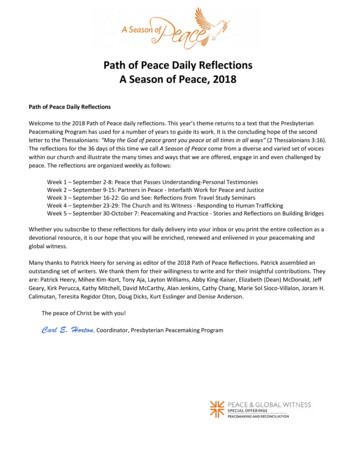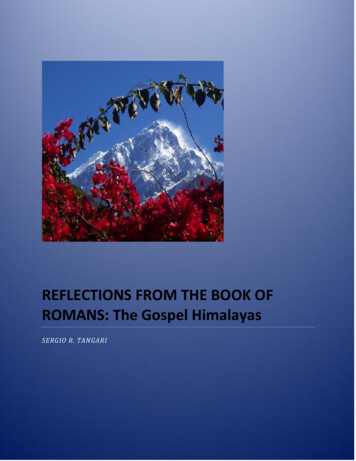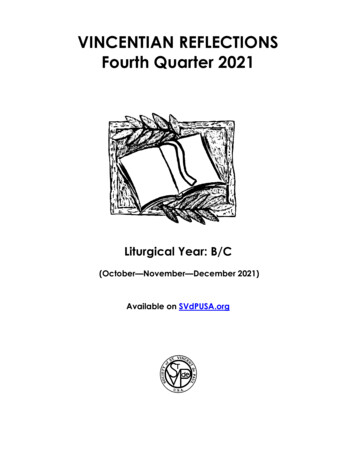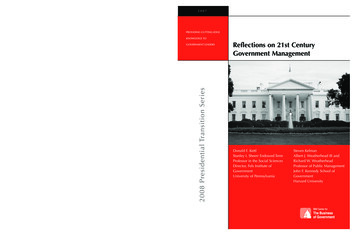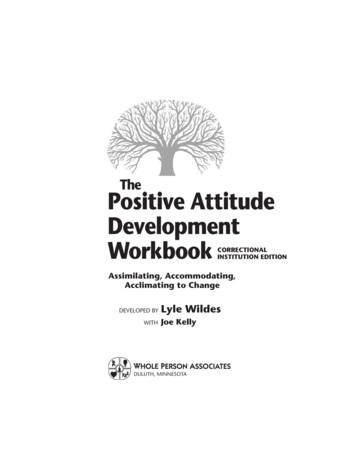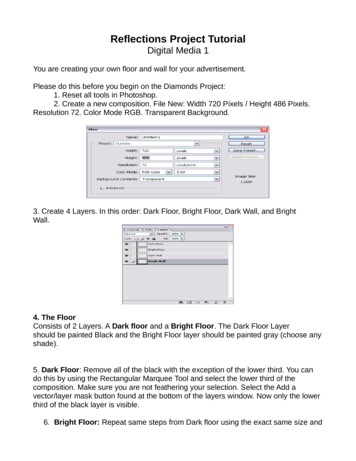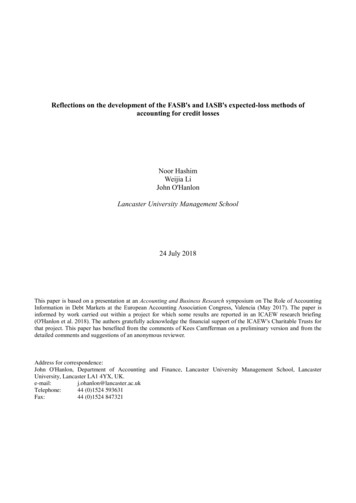
Transcription
Reflections on the development of the FASB's and IASB's expected-loss methods ofaccounting for credit lossesNoor HashimWeijia LiJohn O'HanlonLancaster University Management School24 July 2018This paper is based on a presentation at an Accounting and Business Research symposium on The Role of AccountingInformation in Debt Markets at the European Accounting Association Congress, Valencia (May 2017). The paper isinformed by work carried out within a project for which some results are reported in an ICAEW research briefing(O'Hanlon et al. 2018). The authors gratefully acknowledge the financial support of the ICAEW's Charitable Trusts forthat project. This paper has benefited from the comments of Kees Camfferman on a preliminary version and from thedetailed comments and suggestions of an anonymous reviewer.Address for correspondence:John O'Hanlon, Department of Accounting and Finance, Lancaster University Management School, LancasterUniversity, Lancaster LA1 4YX, UK.e-mail:j.ohanlon@lancaster.ac.ukTelephone:44 (0)1524 593631Fax:44 (0)1524 847321
Reflections on the development of the FASB's and IASB's expected-loss methods ofaccounting for credit lossesAbstractAfter the financial and banking crisis of the late 2000s, the FASB and the IASB aimed to developmethods of accounting for credit losses that would give more timely recognition of those losses.The IASB (in 2009) and the FASB (in 2010) each initially issued its own exposure draft proposingseparate approaches to achieving this. They then attempted to agree a converged expected-lossbased method for accounting for credit losses, but failed to achieve convergence. They then eachissued an accounting standard that included its own expected-loss method, with effective dates of2018 for the IASB and 2020/21 for the FASB. This paper provides an overview of the developmentof proposals and standards in relation to accounting for credit losses issued by the standard settersfrom 2009 to 2016. It then offers reflections on difficulties that the standard setters faced in thisarea and on problems that might arise after the new standards become effective. It raises thequestion of whether a route based on 'expected loss', which in relation to credit losses is a conceptthat originally became prominent for the purpose of setting banks' capital requirements, was helpfulto the process of improving the accounting for credit losses.Keywords: financial accounting; impairment; expected loss; incurred loss; convergence
Reflections on the development of the FASB's and IASB's expected-loss methods ofaccounting for credit losses1. IntroductionThe financial and banking crisis of the late 2000s prompted the Financial AccountingStandards Board (FASB) and the International Accounting Standards Board (IASB) toemphasise jointly 'the importance of working cooperatively and in an internationallycoordinated manner to consider accounting issues emerging from the crisis' and to say that'the FASB and the IASB recognize that the urgency of the credit crisis requiresunprecedented action'.1 An issue that attracted particular attention was a perceived lack oftimeliness in the then-current methods of accounting for credit losses, which is a highlymaterial item for banks.2 The FASB and the IASB moved quickly to address this issue. Inlight of elements of the history of accounting for credit losses and relevant prior literature, wereflect on the process that standard setters went through in the aftermath of the crisis in orderto achieve more timely accounting recognition of credit losses. Within this, we consider thedifficulties that the standard setters faced, including in relation to their failure to achieve aconverged common solution on accounting for credit losses.At the time of the financial and banking crisis, both U.S. GAAP and IFRS requiredthat credit losses should be accounted for using incurred-loss (hereinafter, IL) methods: creditlosses should only be recognised where there was evidence based on past events that a losshad been incurred. The IL methods in place at that time were more heavily weighted towardslimiting earnings management and the associated overstatement of loss allowances thantowards permitting the exercise of discretion that might facilitate timely recognition of creditlosses and ensure loss-allowance adequacy. At the time of the crisis, concern that therestrictive IL methods had contributed to delay in recognition of credit losses prior to thecrisis prompted calls for more forward-looking methods that would result in the more timely1
recognition of losses, including from a prudential-regulatory perspective from the FinancialStability Board's report to G20 leaders (Financial Stability Board 2009) and the BaselCommittee on Banking Supervision (hereinafter, BCBS) (BCBS, 2009). Consistent withadvice from these sources and from the Financial Crisis Advisory Group (2009), the FASBand the IASB each pursued the development of more forward-looking methods of accountingfor credit losses, including methods described as expected-loss (hereinafter, EL) methods.With regard to accounting for credit losses, the crisis appears to have prompted a shift inrelative emphasis away from limiting earnings management and the associated overstatementof loss allowances and towards permitting the exercise of discretion that might facilitatetimely recognition of credit losses and help to ensure that loss allowances are adequate.The standard setters' process of developing methods that would lead to the moretimely recognition of credit losses included the initial issue of separate IASB and FASBexposure drafts (IASB 2009, FASB 2010a), the issue of a joint supplementary document andfollow-up proposals aimed at achieving a converged common solution (FASB/IASB 2011a,b), and the eventual failure of the attempt to achieve convergence. The standard setters thenissued separate final exposure drafts (FASB 2012, IASB 2013a) and separate accountingstandards (IASB 2014a, FASB 2016) with an effective date of 2018 for the IASB and 2020 or2021 for the FASB.Within their development of more timely methods of accounting for credit losses, thestandard setters aimed to address the issue of the breadth of the information set that could beused to support the recognition of credit-loss impairment. They also aimed to address theperhaps less obvious issue that, when loans are made, the lender expects to suffer some asyet-unidentified credit losses that are compensated within the interest revenue that is typicallyaccrued in full from year 1 onwards. Under the IL regimes in place, recognition of theassociated initially-expected losses was delayed until loss events occurred, which typically2
resulted in some of the credit-premium-inclusive interest revenue being recognised inadvance of the associated losses. In their initial exposure drafts (IASB 2009, FASB 2010a),the two standard setters each proposed a credit-loss-accounting method that would allowexpected losses to be recognised in advance of the occurrence of the type of loss eventsrequired by pre-existing IL methods. The methods proposed in those two exposure draftswere based on different objectives. The FASB's objective was to ensure that loss allowancesat each reporting date were sufficient to cover all estimated credit losses for the remaininglife of in-scope financial assets. This led to a proposed method involving the establishment ofloss allowances at the first reporting date after origination or purchase, sometimes referred toas 'day 1', which would immediately reflect initial expectations of all future credit lossesexpected to occur over the full contractual life of assets. The IASB's objective was to reflectinitially-expected credit losses within the calculation of the effective interest rate on financialassets. This led to a proposed method that explicitly linked initially-expected credit losseswith the pricing of financial assets at origination, and would result in the recognition ofinitially-expected losses being spread over the life of assets. Like the FASB's proposedmethod, this method would require credit losses to be recognised in advance of the type ofloss events required under pre-existing IL methods. However, it was less conservative thanthe FASB's proposed method in that recognition of initially-expected losses would be spreadover the life of assets rather than occurring immediately at day 1. The initial IASB methodwas widely regarded as conceptually strong in the sense that it reflected the economicsubstance of the relationship between the contractual interest rate and initially-expectedlosses.3 However, it was also widely regarded as posing a significant implementationchallenge.Subsequent joint deliberations by the FASB and the IASB based on FASB/IASB(2011a, b) were aimed at achieving a compromise converged solution that would partially3
address the objectives of each standard setter. Within these joint deliberations, the FASB andthe IASB achieved straightforward and converged agreement that the information set thatcould be used to support credit-loss impairment would henceforth be broadened to includereasonable and supportable forecasts. This should address to a significant degree the concernsraised in the aftermath of the financial and banking crisis about delay in the accountingrecognition of information about credit losses. However, the standard setters encountered aserious problem in their attempts to reach a converged solution for the treatment of initiallyexpected losses, and this contributed significantly to their inability to achieve a convergedoverall solution with respect to accounting for credit losses. The joint deliberationseliminated from consideration methods that explicitly spread the recognition of initiallyexpected losses across time. They produced a proposal that financial assets should becategorised with regard to whether or not their credit quality had significantly deterioratedsince initial recognition: at each reporting date, allowances would recognise lifetime expectedlosses for assets that had significantly deteriorated since initial recognition ('bad book'); ateach reporting date, including day 1, they would recognise 12-month expected losses forassets that had not significantly deteriorated since initial recognition ('good book'). The IASBaccepted this proposal, seeing the 12-month allowance for good-book assets as a means ofachieving in a practicable way an approximation to the recognition of initially-expectedlosses over time, which was a central feature of IASB (2009). However, after extensiveinvolvement in the deliberations, the FASB indicated that it could not accept this proposaland that it could only accept full recognition at each reporting date, including at day 1, of allexpected losses over the full contractual life of assets. The IASB's preferred approach wasseen by the FASB as insufficiently conservative; the FASB's preferred approach was seen bythe IASB as excessively conservative. There is evidence that the FASB's more conservativepreference was due in part to pre-existing practice that reflected prudential-regulatory-related4
influence. After their failure to agree on this issue, the two standard setters proceeded todevelop standards containing separate EL methods based on their respective preferences(IASB 2014a, FASB 2016). The process of developing the FASB and IASB standards oncredit-loss impairment has been controversial both because of the failure to achieve aconverged common solution and because of some of the proposals themselves. Both standardsetters' requirements for the immediate establishment of loss allowances at day 1, 12-monthexpected losses in the case of the IASB and full-contractual-life losses in the case of theFASB, attracted significant criticism on conceptual grounds.In this paper, we describe the events outlined above in the context of the history ofaccounting for credit losses and relevant prior literature and drawing on our confidentialconversations with senior observers of the process. We then highlight two issues that maygive rise to problems when the new credit-loss-impairment standards are implemented: theFASB's requirement for lifetime loss allowances and the day-1 loss requirements of bothstandard setters. We then consider whether, in light of issues arising during the developmentof the new EL credit-loss-impairment methods, improved methods of accounting for creditlosses might have been more straightforwardly achieved through an alternative route to thetype of EL route that was followed. In particular, we raise the question of whether, after theelimination from consideration of spreading-based EL approaches that did not involve day-1losses, satisfactory more-forward-looking methods of accounting for credit losses that did notinvolve day-1 losses and that might have presented a lower barrier to FASB/IASBconvergence might have been developed by following a less radical broader-information-setbased modified-IL-type route rather than by continuing to follow an EL route.The paper is structured as follows. Section 2 provides background on the IL methodof accounting for credit losses under U.S. GAAP and IFRS, provides background on bankregulation relating to credit losses and provides an outline of elements of prior academic5
literature that are relevant to the matters addressed in this paper. Section 3 outlines thedevelopment since 2009 by the FASB and the IASB of more timely methods of accountingfor credit-loss impairment, including with reference to important elements of feedback on thestandard setters' various proposal documents. Section 4 discusses issues that have arisenduring the standard setters' development of their EL methods of accounting for credit lossesthat may present problems when the standards become effective. Section 5 considers whethera route based on EL was helpful to the process of improving the accounting for credit losses.Section 6 concludes.2.Background and literature reviewThis section provides a summary of background and literature relevant to the eventsconsidered in this paper. Subsection 2.1 provides a summary of the history of the pre-existingIL methods of accounting for credit losses and of the pressure in the wake of the financial andbanking crisis of the late 2000s to replace them by more forward-looking methods.Subsection 2.2 provides some background on bank regulation that relates to credit losses.Subsection 2.3 provides a summary of relevant academic literature.2.1.The incurred-loss method of accounting for credit-loss impairmentAt the time of the financial and banking crisis of the late 2000s, the IL method for credit-lossimpairment, which required that the recognition of loan losses should be supported byevidence that a loss had been incurred, was established in U.S. GAAP and in IFRS. Thissubsection provides some background on the IL methods in U.S. GAAP and IFRS that isrelevant to the events considered in this paper.6
2.1.1. U.S. GAAP: Incurred-lossThe history of IL in U.S. GAAP includes action motivated by the perceived need to constraindiscretion that might allow systematic delay in loan-loss recognition and understatement ofloss allowances and, subsequently, action motivated by the perceived need to constraindiscretion that might allow systematic overstatement of loss allowances. The latter of theseappears to have contributed to criticism at the time of the financial and banking crisis of thelate 2000s of the lack of timeliness of pre-existing methods of accounting for credit losses.From 1975, SFAS 5 (FASB 1975) provided guidance on recognition of losses onreceivables including loans. It included the following requirement:An estimated loss from a loss contingency (as defined in paragraph 1) shall beaccrued by a charge to income if both of the following conditions are met:a. Information available prior to issuance of the financial statements indicatesthat it is probable that an asset had been impaired or a liability had beenincurred at the date of the financial statements. It is implicit in thiscondition that it must be probable that one or more future events will occurconfirming the fact of the loss.b. The amount of loss can be reasonably estimated. (FASB 1975, paragraph 8)Following the savings and loan crisis of the late 1980s, SFAS 5 was criticised for beingambiguous and so flexible that financially weak banks were able to manage earnings upwardsby delaying recognition of losses (GAO 1991, GAO 1992). In May 1993, the FASB issuedSFAS 114 (FASB 1993a). This was aimed at providing clearer and more consistent guidanceon accounting for impairment of loans, other than small homogeneous loans collectivelyevaluated for impairment, including with respect to issues raised in GAO (1992). Thecriterion for recognition of impairment in SFAS 114 was consistent with that in SFAS 5, butthe more specific guidance might have been expected to reduce the danger referred to byGAO (1992) that discretion might be used inappropriately in order to delay the recognition ofloan losses. SFAS 114 (FASB 1993a) included the following reminder aimed at avoidingunduly restrictive interpretation of the IL requirement of FASB (1975):7
The term probable is further described in paragraph 84 of Statement 5, whichstates:The conditions for accrual in paragraph 8 [of Statement 5] are notinconsistent with the accounting concept of conservatism. Those conditionsare not intended to be so rigid that they require virtual certainty before aloss is accrued. They require only that it be probable that an asset has beenimpaired or a liability has been incurred and that the amount of loss bereasonably estimable. (FASB 1993a, paragraph 10)Also in May 1993, the FASB issued SFAS 115 (FASB 1993b), which was motivated in partby a perceived need for more consistent guidance on impairment of debt securities. The ILcredit-loss impairment requirements of SFAS 5, SFAS 114 and SFAS 115 were included inthe pre-FASB (2016) FASB codification topics 450, 310 and 320, respectively. FASBcodification topic 310 includes the following with respect to loan impairment:The following provides an overview of generally accepted accounting principles (GAAP)for loan impairment:a. It is usually difficult, even with hindsight, to identify any single event thatmade a particular loan uncollectible. However, the concept in GAAP is thatimpairment of receivables shall be recognized when, based on all availableinformation, it is probable that a loss has been incurred based on past eventsand conditions existing at the date of the financial statements.b. Losses shall not be recognized before it is probable that they have beenincurred, even though it may be probable based on past experience thatlosses will be incurred in the future. It is inappropriate to consider possibleor expected future trends that may lead to additional losses. (FASBCodification, paragraph 310-10-35-4)In the years following the issue of SFAS 114 and in contrast to the concern aboutunderstatement of losses raised prior to the issue of SFAS 114, concern was expressed bySEC representatives that U.S. banks might be using discretion inappropriately in order tofacilitate earnings management through overstatement of loan-loss allowances.4 In 1998 theSEC questioned the loan-loss accounting of SunTrust Banks Inc. and required it to reduce itsloan-loss allowance by 100 million. During the SunTrust investigation, the SEC also sentletters to a number of U.S. banks questioning their loan-loss allowances (Meyer 1999). Theseactions were viewed as a warning signal to all U.S. banks that the SEC would not tolerateover-provisioning for loan losses during good times. However, U.S. bank regulators did not8
believe that the loan-loss allowances of U.S. banks were systematically excessive. They wereconcerned that the SEC's actions might create a perception that loan-loss allowances wouldhave to be reduced, and claimed that any general downward pressure on allowances couldhave a serious effect on the safety of the U.S. banking system (Meyer 1999, Rushton 1999).There was concern on the part of U.S. banks that they might be caught in a conflict betweenthe SEC and U.S. bank regulators, with the former requiring lower allowances and the latterrequiring higher allowances (Wall and Koch 2000, pp. 1-2). There ensued a debate betweenthe SEC, the FASB and U.S. bank regulators on accounting for credit losses. Then, in July2001, the SEC and bank regulators stated their joint position on loan-loss allowances in SAB1025 and FFIEC (2001), respectively, which required banks to estimate loan-loss allowancesin accordance with GAAP with enhanced documentation to support their allowanceestimates. The joint guidance of 2001 might be seen as a tightening of IL loan-lossrecognition requirements or, at least, as a reaffirmation of the IL principle in U.S. GAAP(Camfferman 2015, p. 8).Such tightening might be expected to limit loan-loss-related earnings management,but at the cost of reduced timeliness in loan-loss recognition. Evidence in Balla and Rose(2015) and Beck and Narayanamoorthy (2013) suggests that this may have occurred. Ballaand Rose (2015) find that, after the guidance of 2001, the relationship between earnings andloan-loss expense weakened, indicating reduced earnings management; however, they alsoclaim that the guidance constrained U.S. banks' early recognition of losses in the years priorto the crisis of the late 2000s. Beck and Narayanamoorthy (2013) report that, after the SAB102 and FFIEC (2001) guidance became effective, the estimation of banks' loan-lossallowances appeared to become more reliant on past charge-offs and less reliant on currentnon-accrual loans. This was accompanied by a decline in the informativeness, as proxied bythe ability to explain future losses, of the loss allowances of weak banks after SAB 102 and9
FFIEC (2001) became effective and especially immediately before the financial and bankingcrisis. The authors suggest two possible reasons for this. First, in the relatively unstableenvironment faced by weak banks, more forward-looking indicators such as non-accrualloans are likely to be more beneficial than backward-looking indicators such as past chargeoffs in enhancing the informativeness of loss allowances. Second, although SAB 102 andFFIEC (2001) may have been effective in constraining overstatement of loss allowances, theycould not be expected to be effective in constraining weak banks' management of earningsthrough delay in the recognition of loan losses.6The perception that effects of the sort indicated by Balla and Rose (2015) and Beckand Narayanamoorthy (2013) were at work prior to the crisis led to a swing, in the aftermathof the financial and banking crisis, away from concern about earnings management andtowards concern about timeliness of loss recognition and loss-allowance adequacy. This wasreflected in, among other things, the comments made in 2009 by the Comptroller of theCurrency, John Dugan, to the effect that, in the prolonged period of benign economicconditions before the late-2000s crisis, a number of banks had felt constrained in their abilityto document adequately the judgmental factors that might have allowed them to makeprovisions that were higher than historical experience would imply.72.1.2. IFRS: Incurred-lossIn common with the history of IL in U.S. GAAP, the history of IL in IFRS includes actionthat appears to have been motivated by the perceived need to constrain discretion that mightallow earnings management. It also includes some indication of the lack of a clear-cutdistinction between IL and EL that we refer to later in this paper.10
Prior to the 2003 revision of IAS 39, the word 'incurred' was not used in IAS 39 inconnection with impairment relating to credit losses. The requirements of the pre-2003version of IAS 39 included the following:A financial asset is impaired if its carrying amount is greater than its estimatedrecoverable amount. An enterprise should assess at each balance sheet datewhether there is any objective evidence that a financial asset or group of assetsmay be impaired. If any such evidence exists, the enterprise should estimatethe recoverable amount of that asset or group of assets and recognise anyimpairment loss [ ] Objective evidence that a financial asset or group ofassets is impaired or uncollectable includes information that comes to theattention of the holder of the asset about:a. significant financial difficulty of the issuer;b. an actual breach of contract, such as a default or delinquency in interestor principal payments;c. granting by the lender to the borrower, for economic or legal reasonsrelating to the borrower's financial difficulty, of a concession that thelender would not otherwise consider;d. a high probability of bankruptcy or other financial reorganisation of theissuer;e. recognition of an impairment loss on that asset in a prior financialreporting period;f. the disappearance of an active market for that financial asset due tofinancial difficulties; org. a historical pattern of collections of accounts receivable that indicates thatthe entire face amount of a portfolio of accounts receivable will not becollected.The disappearance of an active market because an enterprise's securities are nolonger publicly traded is not evidence of impairment. A downgrade of anenterprise's credit rating is not, of itself, evidence of impairment, though itmay be evidence of impairment when considered with other availableinformation. (IASB 2000, paragraphs 109-110)Although the term 'incurred' was not used in the credit-loss impairment requirements of thepre-2003 version of IAS 39, the evidence requirements quoted above were similar to those ofthe 2003 revision of IAS 39, which are commonly regarded as IL.In a detailed review of events related to the 2003 revision of the credit-lossimpairment requirements of IAS 39, Camfferman (2015, p. 4) notes that the practice ofmaking a distinction between IL and EL in the context of accounting for credit losses onlystarted to become common at the time of the deliberations leading up to that 2003 revision.8However, the distinguishing features of EL relative to IL in relation to accounting for credit11
losses were not clear at that time, as was illustrated by the following from the Basis forConclusions of the 2003 revision of IAS 39:Some respondents to the Exposure Draft were confused about whether theExposure Draft reflected an 'incurred loss' model or an 'expected loss' model.(IASB 2003, paragraph BC108)Camfferman (2015) observes that the IASB's deliberations in relation to the 2003 revision ofIAS 39 tended at times towards more forward-looking EL-type features and tended at othertimes towards strengthening and emphasising the pre-existing loss-event-focused IL-typefeatures of the IAS 39 requirements. The IASB eventually came down on the side of anaffirmation of IL. Camfferman (2015) comments as follows that the desirability ofconvergence with U.S. GAAP and the need to constrain earnings management wereinfluential in leading to that outcome:The IASB acted under time pressure to improve the standards inherited fromthe IASC for the first mass adoption of IFRS in 2005, with the result that thewording of the standard as finally approved by the Board, with respect to loanimpairment, differed considerably from the proposals on which constituentshad been asked to comment. In the end, the importance attached toconvergence with U.S. Generally Accepted Accounting Principles (U.S.GAAP) and the prevailing of an anti-abuse perspective on the issue seem tohave tilted the Board towards a strict incurred-loss model. (Camfferman 2015,p. 3)The revised IAS 39 impairment requirements were as follows:A financial asset or a group of financial assets is impaired and impairmentlosses are incurred if, and only if, there is objective evidence of impairment asa result of one or more events that occurred after the initial recognition of theasset (a 'loss event') and that loss event (or events) has an impact on theestimated future cash flows of the financial asset or group of financial assetsthat can be reliably estimated. [ ] Losses expected as a result of futureevents, no matter how likely, are not recognised. Objective evidence that afinancial asset or group of assets is impaired includes observable data thatcomes to the attention of the holder of the asset about the following lossevents:a.significant financial difficulty of the issuer or obligor;b.a breach of contract, such as a default or delinquency in interest orprincipal payments;c.the lender, for economic or legal reasons relating to the borrower'sfinancial difficulty, granting to the borrower a concession that thelender would not otherwise consider;12
d.e.f.it becoming probable that the borrower will enter bankruptcy or otherfinancial reorganisation;the disappearance of an active market for that financial asset becauseof financial difficulties; orobservable data indicating that there is a measurable decrease in theestimated future cash flows from a group of financial assets since theinitial recognition of those assets, although the decrease cannot yet beidentified with the individual financial assets in the group, including:i. adverse changes in the payment status of borrowers in the group(e.g., an increased number of delayed payments or an increasednumber of credit card borrowers who have reached their credit limitand are paying the minimum monthly amount); orii. national or local economic conditions that correlate with defaults onthe assets in the group (e.g., an increase in the unemployment ratein the geographical area of the borrowers, a decrease in propertyprices for mortgages in the relevant area, a decrease in oil prices forloan assets to oil producers, or adverse changes in industryconditions that affect the borrowers in the group). (IASB 2003,paragraph 59)Significant changes introduced in the 2
follow-up proposals aimed at achieving a converged common solution (FASB/IASB 2011a, b), and the eventual failure of the attempt to achieve convergence. The standard setters then issued separate final exposure drafts (FASB 2012, IASB 2013a) and separate accounting standards (IASB 2014a, FASB 2016) with an effective date of 2018 for the IASB and .


